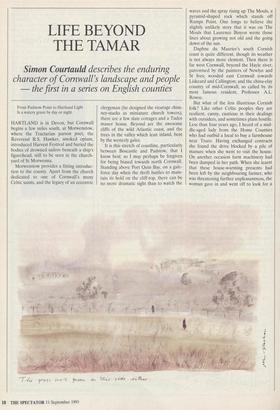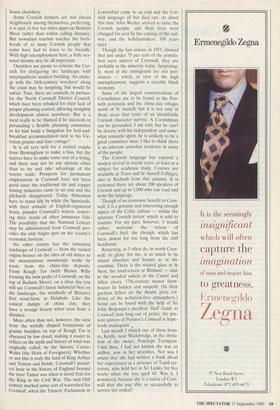LIFE BEYOND THE TAMAR
Simon Courtauld describes the enduring
character of Cornwall's landscape and people the first in a series on English counties
From Padstow Point to Hartland Light Is a watery grave by day or night.
HARTLAND is in Devon, but Cornwall begins a few miles south, at Morwenstow, where the Tractarian parson poet, the Reverend R.S. Hawker, smoked opium, introduced Harvest Festival and buried the bodies of drowned sailors beneath a ship's figurehead, still to be seen in the church- yard of St Morwenna.
Morwenstow provides a fitting introduc- tion to the county. Apart from the church dedicated to one of Cornwall's many Celtic saints, and the legacy of an eccentric clergyman (he designed the vicarage chim- ney-stacks as miniature church towers), there are a few slate cottages and a Tudor manor house. Beyond are the awesome cliffs of the wild Atlantic coast, and the trees in the valley which lean inland, bent by the westerly gales.
It is this stretch of coastline, particularly between Boscastle and Padstow, that I know best; so I may perhaps be forgiven for being biased towards north Cornwall. Standing above Port Quin Bay, on a gale- force day when the thrift battles to main- tain its hold on the cliff-top, there can be no more dramatic sight than to watch the waves and the spray rising up The Mouls, a pyramid-shaped rock which stands off Rumps Point. One longs to believe the slightly unlikely story that it was on The Mouls that Laurence Binyon wrote those lines about growing not old and the going down of the sun.
Daphne du Maurier's south Cornish coast is quite different, though its weather is not always more clement. Then there is far west Cornwall, beyond the Hayle river, patronised by the painters of Newlyn and St Ives; wooded east Cornwall towards Liskeard and Callington; and the china-clay country of mid-Cornwall, so called by its most famous resident, Professor A.L. Rowse.
But what of the less illustrious Cornish folk? Like other Celtic peoples they are resilient, canny, cautious in their dealings with outsiders, and sometimes plain hostile. Less than four years ago, I heard of a mid- dle-aged lady from the Home Counties who had outbid a local to buy a farmhouse near Truro. Having exchanged contracts she found the drive blocked by a pile of manure when she went to visit the house. On another occasion farm machinery had been dumped in her path. When she learnt that these house-warming presents had been left by the neighbouring farmer, who was threatening further unpleasantness, the woman gave in and went off to look for a house elsewhere.
Some Cornish farmers are not always neighbourly among themselves, preferring, It is said, to live ten miles apart on Bodmin Moor rather than within calling distance. But nowadays tourism touches the liveli- hoods of so many Cornish people that some have had to learn to be friendly. With high unemployment here, a little sea- sonal income may be all-important.
Outsiders are prone to criticise the Cor- nish for disfiguring the landscape with unsympathetic modern building. An analo- gy with the 18th-century 'wreckers' along the coast may be tempting, but would be unfair. True, there are councils, in particu- lar the North Cornwall District Council, which have been rebuked for their lack of proper planning control, allowing unsightly development almost anywhere. But is a local really to be blamed if he succeeds in persuading a flexible planning committee to let him build a bungalow for bed-and- breakfast accommodation next to his Vic- torian granite and slate cottage?
It is all very well for a retired couple from Birmingham to make a fuss, but the natives have to make some sort of a living, and there may not be any options other than to try and take advantage of the tourist trade. Prospects for permanent employment in Cornwall have not been good since the traditional tin and copper mining industries came to an end and the pilchards disappeared. Today, fishermen have to stand idly by while the Spaniards, with their armada of English-registered boats, plunder Cornwall's waters, remov- ing their stocks of often immature fish. The possibility that the National Lottery may be administered from Cornwall pro- vides the only bright spot on the county's economic horizon.
No other county has the industrial landscape of Cornwall — from the ruined engine-houses on the sites of old mines to the mountainous moonscape made by waste from the china-clay deposits. From Rough Tor (with Brown Willy forming the twin peaks of Cornwall, on the top of Bodmin Moor), on a clear day you will see Cornwall's latest industrial blot on the landscape, the windmills of Britain's first wind-farm, at Delabole. Like the conical dumps of china clay, they have a strange beauty when seen from a distance.
More often than not, however, the view from the weirdly shaped formations of granite boulders on top of Rough Tor is obscured by low cloud, making it easier to reflect on the myth and history of what was originally called, by the Saxons, Cornu- Wales (the Horn of Foreigners). Whether or not this is truly the land of King Arthur and Tristan and Isolde, Cornwall's proud- est hour in the history of England beyond the river Tamar was when it stood firm for the King in the Civil War. The mid-18th century marked some sort of watershed for Cornwall, when the Tinners' Parliament in Lostwithiel came to an end and the Cor- nish language all but died out. At about this time John Wesley arrived to tame the Cornish people, and their lives were changed for ever by the coming of the rail- way, and the holidaymakers, 100 years later.
Though the last census, in 1951, showed that just under 70 per cent of the popula- tion were natives of Cornwall, they are probably in the minority today. Surprising- ly, most of the immigrants are not pen- sioners — which, in view of the high unemployment, suggests a sizeable black economy.
Some of the largest concentrations of Cornishmen are to be found in the Pen- with peninsula and the china-clay villages north of St Austell; but it is not only in these areas that traits of an identifiable Cornish character survive. A Cornishman can be persuaded, I am told, but he can't be driven; with his independent and some- what romantic spirit, he is unlikely to be a good committee man. I like to think there is an inherent anarchist tendency in many of the people.
The Cornish language has enjoyed a modest revival in recent years, at least as a subject for academic study. Courses are available at Truro and St Austell Colleges, also at Redruth from this autumn. It is reckoned there are about 200 speakers of Cornish and up to 1,000 who can read and write the language.
Though of no economic benefit to Corn- wall, it is a genuine and interesting enough aspect of the Celtic culture — unlike the spurious 'Cornish tartan' which is sold to tourists. For my part, however, I would rather welcome the return of Cornwall's bird, the though, which has been absent for too long from the cliff headlands.
Returning, as I often do, to north Corn- wall, its glory, for me, is as much in its inland churches and houses as in the coastline. There is the stained glass at St Neot, the rood-screen at Blisland — and, in the wooded valleys of the Camel and Allen rivers, 17th-century manor farm- houses lie hidden and unspoilt. (In their gardens lichen on the shrubs gives evi- dence of the pollution-free atmosphere.) Some can be found with the help of Sir John Betjeman's excellent Shell Guide to Cornwall (too long out of print); the pre- sent edition of Pevsner's Cornwall is hope- lessly inadequate...
Last month I visited one of these hous- es, Kestle, near Wadebridge, at the invita- tion of the owner, Penelope Tremayne. Until then, I had not known she was an author, now in her seventies. Nor was I aware that she had written a book about her experiences as a prisoner of Tamil ter- rorists, who held her in Sri Lanka for five weeks when she was aged 64. Was it, I wondered, because she is a native of Corn- wall that she was able so successfully to survive her ordeal?



















































 Previous page
Previous page